Overview
Gardeners often incorporate shades of black flowers in front of shrubs, along a foundation or border, or as accent plants around a specimen shrubs or trees. Black flowers generally bloom from spring until frost and have characteristics which distinguish them from other flowers.
The right soil and sun encourage healthy growth of black flowers. Black flowers tolerate most well-drained soils, but you can work in a 2-inch layer of compost before planting to improve moisture and nutrient qualities in the bed. They flower best with a full six to eight hours of sun a day, although they can tolerate some afternoon shade with only a slight reduction in blooms. Black flowers also grow well in containers and hanging baskets when you plant them in high-quality potting soil and place them in the sun.
Types/Varieties Of Black Flowers
1. Queen of the Night Tulip
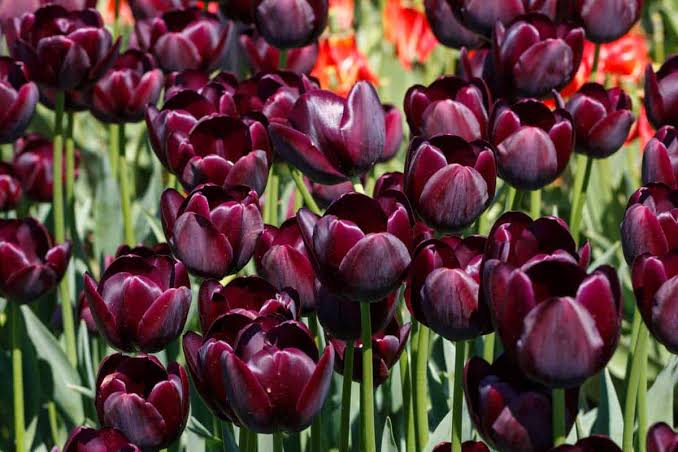
“Queen of the Night” and other single late tulips are the result of extensive breeding of late spring varieties, including old garden plants that have been cultivated for centuries and a more recent type, Darwin tulips. The parent varieties were noted for the ability to return year after year, a trait that varies widely among tulip types and species. The re-blooming trait transferred itself to the single late tulips, which generally have cup-shaped flowers and bloom in a variety of colors in addition to near-black.
2. Black Star Calla Lily
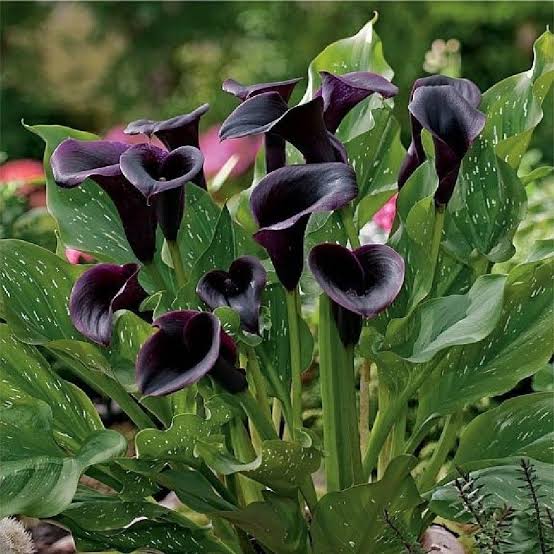
One of the best flowers to use in floral decorations, Black Star is perfect for use in a container on the patio or planted in the garden border. Black Star Calla Lily features bold black trumpet-shaped flowers with plum purple overtones rising above the foliage from early summer to early fall. The flowers are excellent for cutting. Its attractive glossy narrow leaves remain dark green in color with distinctive gray spots throughout the season. The fruit is not ornamentally significant. Its relatively coarse texture can be used to stand it apart from other garden plants with finer foliage.
3. Hellebore
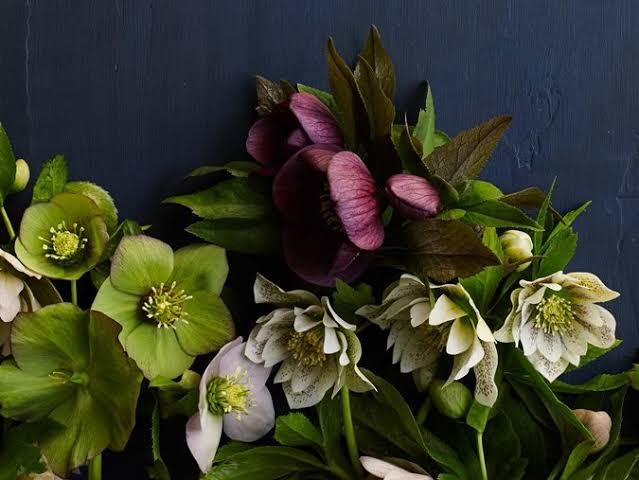
Hellebore plants are among the earliest perennial flowers to bloom, welcoming spring with their rose-like blossoms. Hellebore foliage is evergreen and forms a low clump with leaves that are lobed and palm-like. The flowers resemble roses in shape. Flower stems shoot up above the foliage but nod under the weight of the flowers, which tend to bloom face down. The plant is long blooming, with flowers that are mostly in creamy shades of white, tinged with green or black, tending to change or deepen as they age. With hybridizing, more colors are becoming available.
Also Read: White Flowers
4. Bat Orchid

Tacca chantrieri is a species of flowering plant in the yam family Dioscoreaceae. It is commonly called the black bat flower. Tacca chantrieri is an unusual plant in that it has black flowers. These flowers are somewhat bat-shaped, are up to 12 inches across, and have long ‘whiskers’ that can grow up to 28 inches. Indoor blooms and those outside in semi-tropical climates may appear in spring and last until early autumn. Large, attractive leaves surround the bloom.
Growing bat flowers requires a little extra bat flower care, but blossoms of this unusual specialty plant make the extra care of bat flower worthwhile. An interesting tip found in bat flower info is that large plants usually have a greater rate of success than smaller ones.
5. Black Devil Pansy

The black devil pansy sports pure black petals with a small yellow center. Unlike some black flowers, the petals of black devil pansies are true black without the hint of maroon or purple characteristic of many black flowers. These pansies are ideal for pairing with white flowers to create the appearance of a black and white photos. Like other black flowers, the black pansy is gaining popularity for inclusion in gothic gardens that feature an assortment of black flowers. These cheerful, easy-to-grow perennials do best in a place with any type of soil with average moisture and full sun to partial shade.
6. Night Rider Lily

Large, satiny-textured, deep violet ‘Night Rider’ hybrid lilies make striking additions to containers and flower beds. Each stem produces several buds that open from early to mid summer. The upward-facing flowers work especially well for cut arrangements, too.
Also Read: Hibiscus Flowers
7. Cornflower ‘Black Ball’
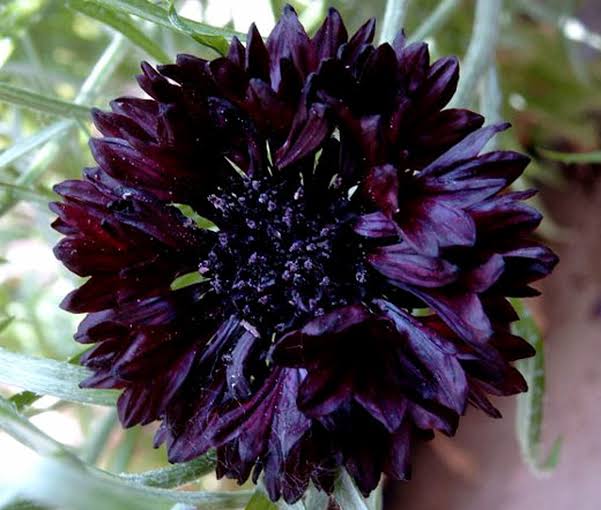
This particular variety is a tall plant that produces stunning, dark rich purple, almost black, double flowers on a top of attractive silvery foliage. Cornflower Black Ball blooms all summer and into fall providing unique and exotic color to the garden and attracting butterflies along with other pollinators.
Cornflower Black Ball is a cottage garden favorite and Cornflower makes an excellent border and cutting garden flower. Cornflower can tolerate drought and adapt to a wide range of soils, as long as a good drainage is provided.
8. Black Velvet Petunia (Petunia x hybrida)

Black Velvet Petunia flowers or foliage make a dramatic addition to the garden. If you’re looking for an annual with a long-lasting dark flower, consider growing petunias (Petunia x hybrida) with black flowers. Like other petunias, the black-flowered variety “Black Velvet” grows well as an annual in all climates, and as a perennial in U.S. Department of Agriculture hardiness zones 10 through 11.
Also Read: Tropical Flowers
9. Chocolate Cosmos (Cosmos atrosanguineus)

Chocolate cosmos, the chocolate cosmos, is a species of Cosmos, native to Mexico. The flowers are produced in a capitulum 3–4.5 cm diameter, dark red to maroon-dark brown, with a ring of six to ten (usually eight) broad ray florets and a center of disc florets; they have a light vanillin fragrance (like many chocolates), which becomes more noticeable towards the end of the day.
10. Viola ‘Molly Sanderson’
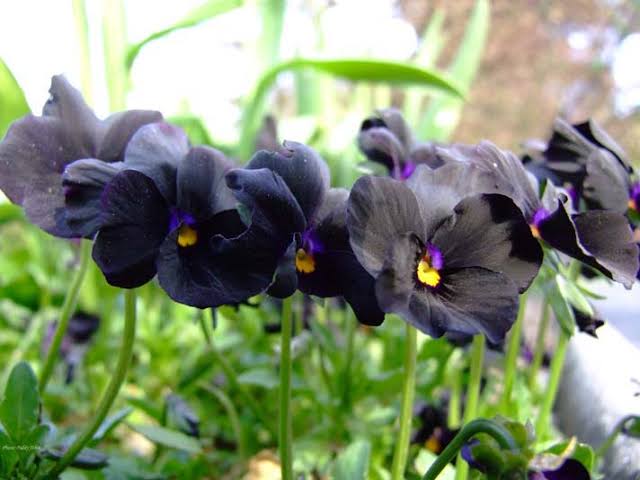
Violas are compact reliably perennial, clump-forming plants with a complex root system and rounded, more or less fragrant flowers, often with darker rays, over a long period in late spring and summer. Viola can be annuals, biennials or deciduous or evergreen perennials, with simple or pinnately lobed leaves and 5-petalled flowers of characteristic shape.
Also Read: Calathea Vittata
11. Iris ‘Before the Storm’
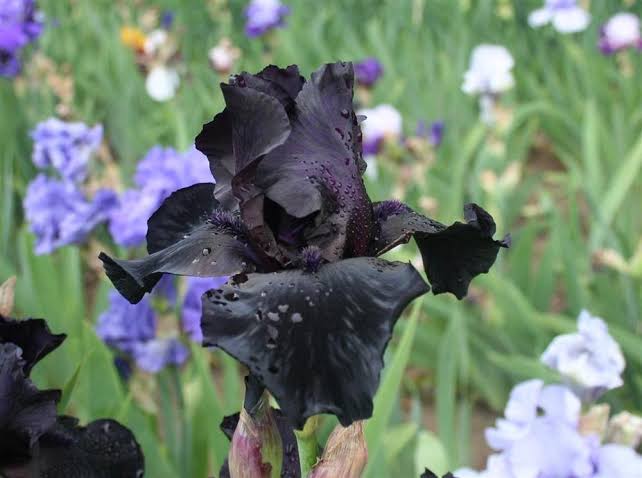
‘Before the Storm’ _ ‘Before the Storm’ is a clump-forming, rhizomatous, herbaceous perennial with sword-shaped, grey-green leaves and sturdy, upright stems bearing large, dark purple to black flowers in late spring and early summer.
12. Chocolate lily (Fritillaria camschatcensis)

A member of the lily family (Liliaceae), chocolate lily grows 8-24 inches tall and its leaves are arranged in whorls of five to nine down the stem. Flowering from May to July, the flowers are dark greenish brown to brownish purple (chocolate colored), sometimes streaked or spotted with yellow and grow close together on short pedicels. The flowers are pollinated by flies, which are attracted by the plant’s foul smell. The bulbs consist of several fleshy scales and their bladelike petioles, which disintegrate into numerous rice-like bulblets.
13. Black Hollyhock

Commonly called black hollyhock, Alcea rosea “Nigra” is an heirloom cultivar grown for its dramatic, dark maroon flowers that look almost black, with a yellow throat on tall flower spikes. The plants grow best within U.S. Department of Agriculture plant hardiness zones 3 to 9, where they will reach a mature height of 5 to 8 feet in their second year. Although technically a biennial plant, black hollyhocks self-sow prolifically and will persist in the garden for many years if not regularly deadheaded during the summer. However, they are otherwise easy to care for if planted in a sunny, fast-draining bed and provided with regular feeding and watering during the summer. Create a unique display in cottage gardens or the back of a border with these richly colored flowers.
Also Read: Black-eyed Susan Varieties
14. Diabolo Ninebark
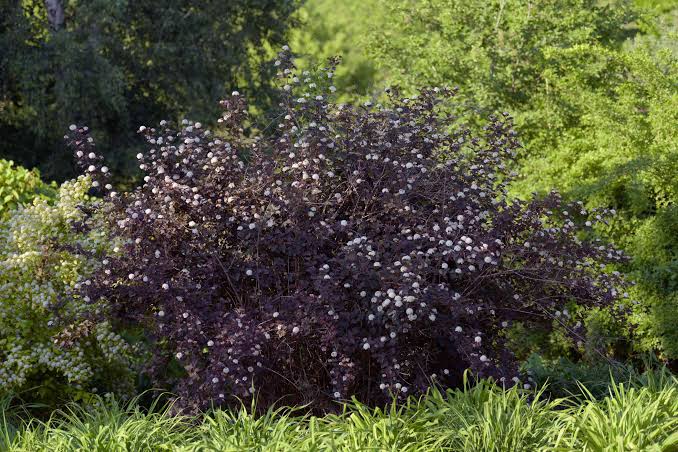
Diablo ninebark’s main feature is its purplish leaves, setting it apart from the species plant, which has green leaves. Some of this shrub’s leaves may green up a bit during hot weather, but the color is a dark green (which is still plenty dark enough to set Diablo ninebark apart from most other shrubs). With flowers in spring, dark foliage in summer, fall foliage in autumn, and peeling bark year-round, there is never a season in which this bush has nothing to offer
15. Weigela Wine and Roses
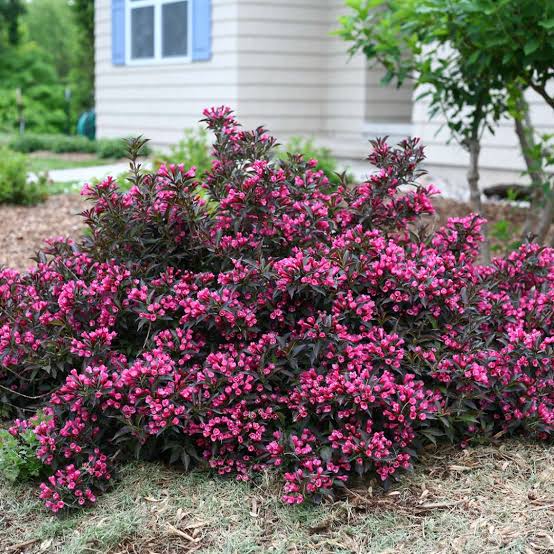
Weigela Wine and Roses (Weigela florida “Alexandra” Wine and Roses), is a deciduous shrub appreciated for the deep rosy-pink blooms that provide contrast for shiny, dark greenish-purple foliage. The blooms appear on the shrub en masse during the spring, then continue to a lesser degree as they deepen in color throughout the summer. Weigela Wine and Roses, which reaches mature heights of 4 to 5 feet, is suitable for growing in warm areas.
16. Black Beauty Elderberry
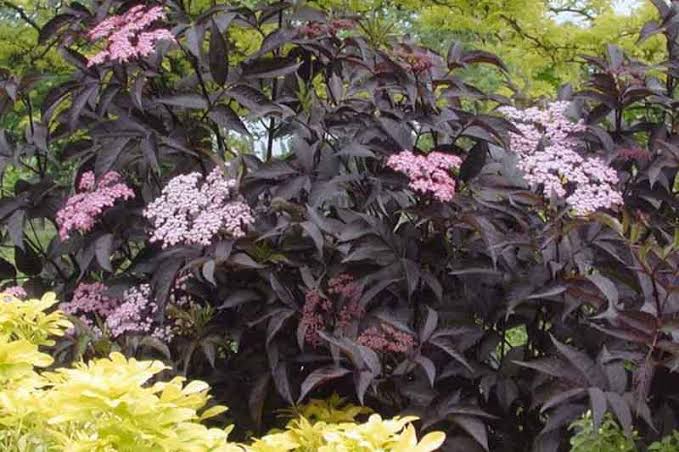
“Black Beauty” elderberries (Sambucus nigra “Black Beauty”) grow dark purple; nearly black leaves and produces clusters of pink flowers in summer. This ornamental fruiting shrub grows in U.S. Department of Agriculture plant hardiness zones 4 to 8. Grow “Black Beauty” in moist, rich soil in a full sun or partially shaded bed to ensure full growth and ample blossoms. With proper care, this elderberry remains healthy and productive.
Also Read: Monstera Varieties
17. Black Mondo Grass

Black mondo grass is a stemless plant on which the leaves sprout from the ground in clumps. In summer, a single flower stalks sprouts, carrying small, bell-shaped, pinkish flowers. Native to Asia, black mondo grass (Ophiopogon planiscapus “Nigrescens”) is an easy-growing, ornamental plant that works well planted along paths, in rock gardens, under trees, as a ground cover for a small area and as a dramatic accent in containers. It grows to about 8 inches tall and spreads at maturity to 1 foot wide. It requires deep watering every two to three weeks and may need more water in hot weather. It will tolerate full sun as well as partially shaded areas and needs well-draining soil, rich soil.
18. Zwartkop Aeonium
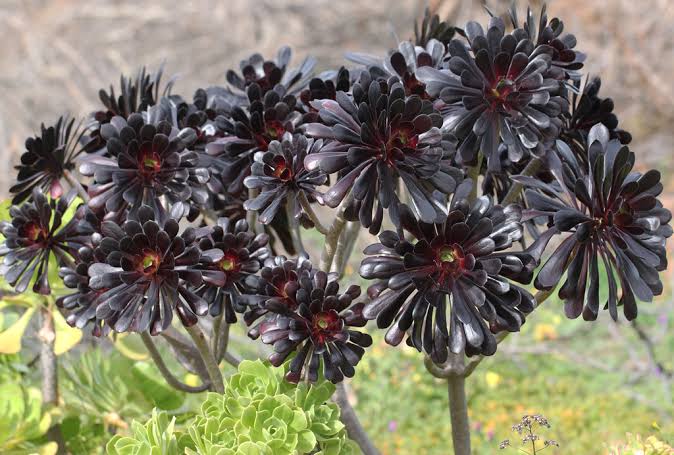
Aeonium arboreum “Zwartkop,” commonly called black rose, is an ornamental succulent grown for its purplish-black foliage, which is arranged in a rosette shape. It grows outdoors in U.S. Department of Agriculture plant hardiness zones 9 through 11, where it adds year-round visual interest to garden beds. The fleshy leaves make these plants quite similar to several other succulent plants, most noticeably Echeveria and Sempervivum—the popular hens and chicks. Aeoniums can be planted in the garden at any time. These are rather slow-growing plants, and it may take as much as five years before they bloom.
Also Read: Calathea Roseopicta
19. Canna Black Tropicanna
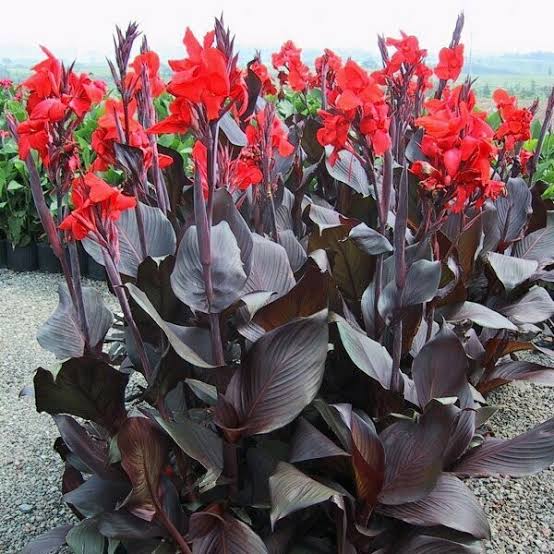
Canna Black Tropicanna is a medium height variety that guarantees an exotic display of deep dark purple black foliage and orange red flowers. This perfect plant adds drama, color and creates a focal point in any garden. The flowers are remarkably easy to grow and look great when planted en-mass. They are ideal for gardens landscapes and water gardens. In a cool climate they will flower summer to autumn and in warm climates spring to autumn.
20. “Black Magic” elephant ears
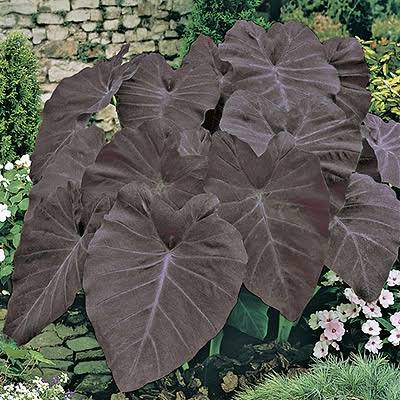
“Black Magic” elephant ears (Colocasia esculenta “Black Magic”), is a perennial member of the Arum family commonly used as a decorative house and garden plant. The fast-growing plants have large, heart-shaped leaves and underground tubers.
‘Black Magic’ Elephant ears grow from 3 to 6 feet tall. Their heart-shaped leaves grow from 12 to 30 inches long and look like taro leaves only they’re purple, not green. Elephant ears are dark purple to nearly black and are spongy, filled with air spaces. They have small, netted veins between larger, parallel lateral veins and deep purple stalks.
Also Read: Fast Growing Evergreen Shrubs
21. Black Prince Coleus
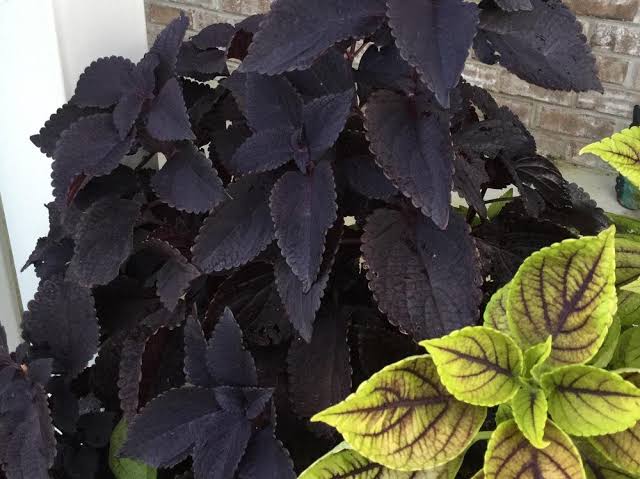
With some of the most colorful foliage of any plant, Black prince coleus is a showstopper in a shady garden. This tender tropical plant has an amazing array of colors and leaf patterns. Look for hot pink, orange, lime green, burgundy, chocolate brown, yellow, lavender and even a purple so dark it looks black. Though coleus does produce spikes of lavender flowers, you’ll appreciate it most for the colorful leaves, which typically look like a rounded triangle with scalloped edges. Other leaf shapes are frilly, skinny or deeply notched, depending on the cultivar.
22. Silver Laced Primerose

Silver and Gold-laced Primroses have been grown in gardens for centuries. This flower produces blooms of deep black-brown with a scalloped silver-white edge and a golden eye. Blooms are fragrant with stems just long enough for cutting, appearing in spring.
23. Bat Flower
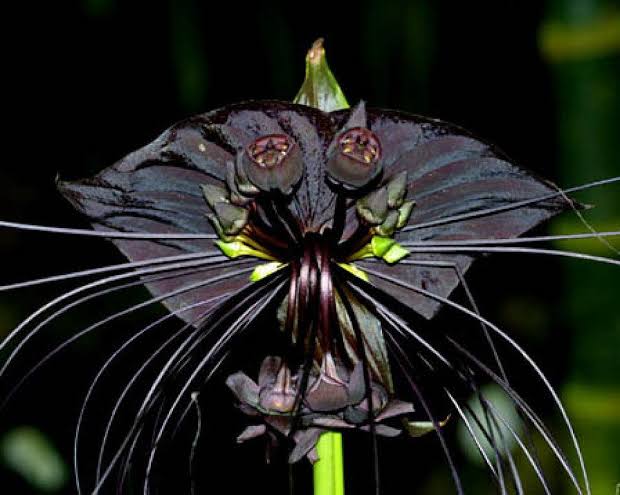
The black bat flower is an exotic looking, unusual plant that is somewhat difficult to grow, but rewarding for its unusual shape, texture and color in the garden. True to its common name, the bat flower looks like a bat with its wing shaped bracts and seed pods that look a bit like bat faces. It is an understory plant native to the forests of Asia and Australia, and grows best in a semi-tropical environment. The roots have medicinal properties, especially for intestinal complaints.
It is sometimes also referred to as tiger beard, due to its long bracteoles which look like whiskers. The purple variety is a dark dusky color that ranges from maroon to purple, but often looks black.
Also Read: Begonia maculata Flower
24. Black Magic Mangave
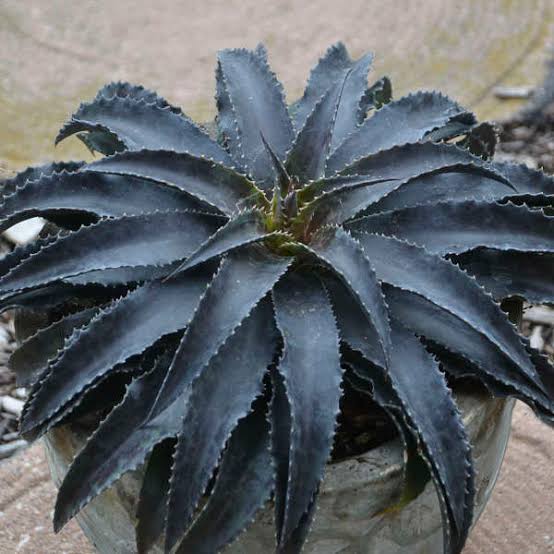
Black Magic Mangave is easily recognizable variety that you can identify by its near back leaves. The long, flat, lance-shaped leaves are so heavily spotted that they appear to solid black. In containers, this leaf tips of this succulent will arch downward. It is beautiful in both mono and combo containers.
25. Sweetunia Black Satin
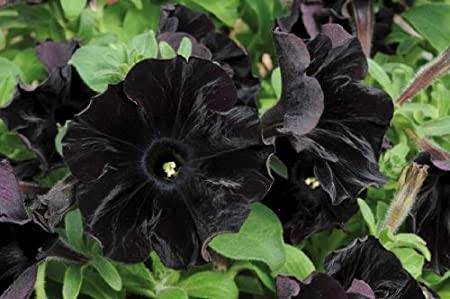
Sweetunia Black Satin Petunia is a dense herbaceous annual with a trailing habit of growth, eventually spilling over the edges of hanging baskets and containers. Its medium texture blends into the garden, but can always be balanced by a couple of finer or coarser plants for an effective composition.
Sweetunia Black Satin Petunia is smothered in stunning black trumpet-shaped flowers at the ends of the stems from mid spring to late summer. Its pointy leaves remain green in color throughout the season. The fruit is not ornamentally significant.
26. Black Prince Echeveria
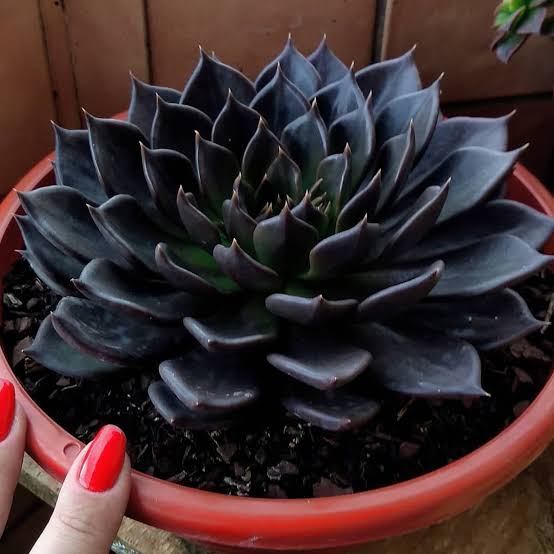
Echeveria ‘Black Prince’ Variegated, also known as Echeveria ‘Bess Bates’ is a variegated cultivar of Echeveria ‘Black Prince’. The leaves are variegated with varying shades of yellow, light green, purple and black. The amount of variegation varies from plant to plant, with some having more shades of yellow than others, and some having all the different colors evenly distributed throughout the plant.
Also Read: Philodendron panduriforme
27. Enchanted Sunrise Begonia
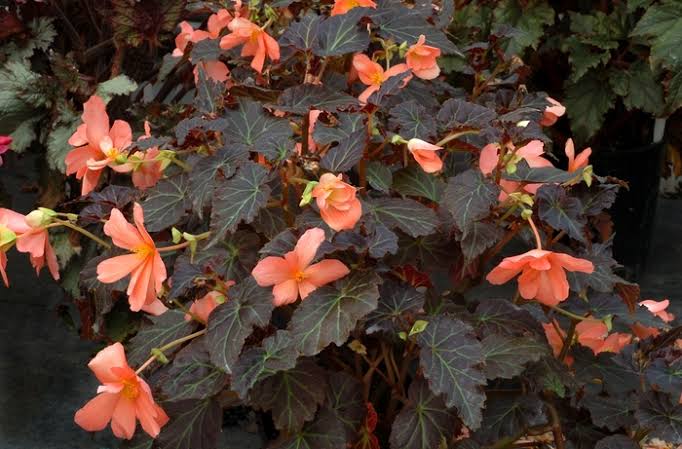
‘Enchanted Sunrise’ begonia has dark cocoa-brown foliage, green veins and large, single, salmon-orange flowers growing in an outward facing cluster. ‘Enchanted Sunrise’ is an upright plant that makes a good house plant. It has a long blooming season and can flower during the winter if kept indoors.
28. ‘Night Embers’ Sedum

This late season bloomer can be admired for its strictly upright habit of dark black-purple, semi-glossy succulent leaves. Small clusters of light mauve pink flowers are produced on deep red stems, the perfect accent color to the darkly colored foliage. Flowers are produced on the top half of this tall Stonecrop, with no lodging. With a narrow base and a vase-like habit, this perennial combines well with shorter companions in a limited space
29. Phormium Tenax ‘All Black’

Phormium tenax ‘All Black’ produces strong upright tufts of very dark foliage which is the perfect complement to brightly colored perennials and bedding plants. They can be damaged by very strong cold winds, so plant in a sheltered spot with moisture retentive but free draining soil.
Also Read: Philodendron Pink Princess
30. Black Cat Pussy Willow

Black Cat Pussy Willow (Salix chaenomeloides) is a large, striking shrub that produces fuzzy catkins in early spring. These catkins start out pink and silver and mature to a deep black. These provide great early spring interest while waiting for spring flowers to bloom. This plant provides great cut flowers, or catkins. It also holds its color nicely when dried. It’s easy to grow and works well as a screen or border.
Further References
- Beautiful Black Flowers: https://leafyplace.com/black-flowers/
- Dramatic Flowers: https://www.hgtv.com/outdoors/flowers-and-plants/32-black-flowers-and-plants-pictures
- Black and White Flowers: https://www.growinganything.com/black-and-white-flowers/
- Black Flowers: https://www.flowerglossary.com/black-flowers/